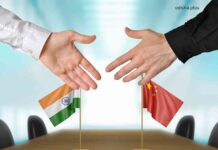Sutanu Guru
More than enough has already been written about the recent state visit of prime minister Narendra Modi to the United States. Both about the grand welcome he was given and the controversy generated over the alleged “backsliding of democracy” during his regime.

I have no intention to add to that noise. Rather, both the optics and the substance of the visit made me go back almost 50 years in history. In 1972 and 1973, the US took steps to “normalise” relations with China. President Richard Nixon went on a much alleged about week-long visit to China where he met the then Supreme Leader Mao Ze Dong. The US had virtually no interaction with the top leadership of China since 1949 when the Communists took control of the country.

The visit was followed by the Paris Peace Accord where America agreed to withdraw its troops from Vietnam. This romancing of China had one Strategic goal: to contain the Soviet Union which was the other Superpower of the world along with the United States and engaged in a Cold War with Uncle Sam.
By 1979, the US established full diplomatic relations with China. Coincidentally, by then the new Supreme Leader of China Deng Xiao Peng had already initiated economic reforms. For three continuous decades after that ostensible Communist China embraced American capital and technology to become the second largest economy of the world. Along the way, the Soviet Union had fallen apart and lost the Cold War.

Today, China is the second Superpower after the United States and a technology, military and geo-strategic rival of the United States. Both countries are engaged in the 21st century version of the Cold War. So the US strategy is clear: just as it left behind all old baggage and embraced China because the main priority was to contain the “menace” of Soviet Union, it seems to be shedding “old hesitations” and baggage of the past because the main priority is to contain the “menace” of China.
Before this, America has never really transferred any technology of substance-be it military or in frontier areas like Artificial Intelligence, telecom and semiconductors, beyond the hype of this visit, these are truly pathbreaking and bold decisions taken by the powers that be in the United States. They have bitten the bullet and decided to bet on India.
So called “liberals” are lamenting that the US is abandoning democratic principles and values and giving a free pass to Modi who, in their opinion, persecutes Muslims and tramples on dissent and free speech. I am not much bothered about that debate because it is quite puerile and juvenile.
In fact, I marvel at the stupidity of the liberals who think the US should “sacrifice India at the altar of democracy” to uphold liberal vales at this juncture in history. The United States has always relentlessly pursed its strategic national interests; democracy, dissent and all that nonsense be damned. Of course, the so called “independent” media in the United States somehow manages to cloak American ruthlessness as a move to enhance democracy in the world.
Look at Iraq and Saddam Hussein. The US wanted a regime change and somehow convinced its allies that Saddam Hussein was building weapons of mass destruction and must be removed. So it invaded Iraq in the name of promoting democracy. Hundreds of thousands of innocent Iraqis were slaughtered but the “liberal” media like The New York Times, The Washington Post and others found nothing wrong with that cruel decision of the US. So Indians too should harbour no illusions about the US and look at the new partnership between the two purely from a pragmatic lens.

The real question that needs to be asked is: Can India be smart enough in the next decade or two like China was in the 1980s and 1990s to leverage the American “generosity” and become a global economic and military powerhouse? Chest thumping Indian nationalists seem to delusionally think that India is already an emerging Superpower. Far from it. Frankly, it is no match for China.
The GDP of China is five times that of India (It was slightly lower than that of India when Richard Nixon visited the country in 1972). The per capita income of China is six times that of India. It is miles ahead of India in military spending. And as events after the Galwan military clash of June 2020 have shown, India is hopelessly dependent on critical technology and equipment important from the last country.
Despite loud noises made about blocking and banning Made in China products after Galwan, India racked up a trade deficit of about $ 100 billion with China last year. It is trying very hard to cut down this dependence. But it will take a long time. However, American help can speed up the process. Even before the consequential Modi visit, American multinationals have publicly announced a China plus one policy to gradually move manufacturing centres from China.
So far, tiny Vietnam has been the main beneficiary with India getting the crumbs. For instance, exports of electronic goods from Vietnam last year were more than $ 120 billion compared to less than $ 25 billion for India. Despite genuine efforts and noises made to improve ease of doing business, stifling land, labor laws and arbitration delays (it takes decades for a case to be settled in India), multinationals remain wary of going the whole hog when it comes to setting up massive factories in India. A great beginning has been made in the last few years, but a lot more needs to be done.
But that is talking about today. The new partnership between the US and India is really about long term: the next two decades. In that context, can India leverage the US the way China did in the past? There are two reasons that make it clear India cannot do a China despite the best of intentions and ambitions.
The first is the difference between the nature of the two regimes. When the US embraced China, it was a totally authoritarian regime. It remains so even now and the new Supreme Leader Xi Jing Ping has fashioned himself as a new age Mao. The Chinese regime did and still takes ruthless reform decisions as and when it thinks they are needed. There is no question of any serious protest or roadblocks.

In contrast, despite all the bleating of “liberals” that Modi is an “authoritarian fascist”, India was and remains a functional democracy. It tried land reforms in 2015. Sustained protests across the country including a jibe by Rahul Gandhi that the Modi regime is a “suit boot ki sarkar” killed that reform. It tried farm law reforms. Protestors blocked highways leading to Delhi for almost a year and created mayhem on Delhi streets on Republic Day in 2021. Modi was forced to withdraw the laws.
In China, such violent protestors would have been summarily shot dead. It has been trying for more than five years to reform labor laws; so far without success. So the Indian democracy will work in its own way and reforms will take time. Don’t expect any miracles. But be proud that, warts and all, Indian democracy works. The Economist and other media outlets including those in India who detest Modi with passion and ferocity will keep claiming otherwise, but Modi simply cannot ram down reform laws the way Chinese rulers can do.
The second reason is sheer luck of China. After a decade and more of reforms beginning 1978 when the Chinese economy started booming, it rode the crest of globalisation. The Soviet Union was dead and globalists were convinced bringing China into the globalisation process will eventually lead to democracy in the country.
Erstwhile authoritarian Indonesia, Malaysia, Thailand, South Korea and Latin American countries had become democracies. That, sadly, remains a pipe dream. When China took full advantage of the globalisation process and started emerging as a de facto Superpower in the first decade of the 21st century, the global economic and financial meltdown happened in 2008.

Then came Covid. There is no doubt that the era of dizzying GDP growth rates and trade are over now. At the peak of globalisation, China grew at 10% a year. In the next decade, India will be lucky to grow on a sustained basis at more than 7% a year. That makes India the fastest growing major economy in the world; but the Chinese miracle looks beyond reach.
Should we bemoan this fact? Not at all. Stumbling along with blockaded highways and a million other mutinies, India will become the third largest economy in the world in the next few years. By next decade, it will be a $10 trillion economy. By then, China will no longer be as serious threat as it is to India right now. For a noisy and fractious democracy, that should be good enough.
(Author has been a media professional for over 3 decades. He is now Executive Director, C Voter Foundation. Views are Personal)



























